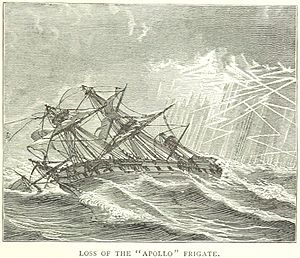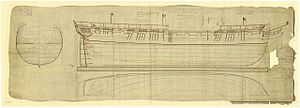HMS Apollo (1799) facts for kids

Apollo sinks on 2 April 1804
|
|
Quick facts for kids History |
|
|---|---|
| Name | Apollo |
| Ordered | 15 September 1798 |
| Builder | Dudman, Deptford Wharf |
| Laid down | November 1798 |
| Launched | 16 August 1799 |
| Fate | Wrecked, 2 April 1804 |
| General characteristics | |
| Class and type | Apollo-class frigate |
| Tons burthen | 956+17⁄94 (bm) |
| Length | 145 ft (44 m) (gundeck); 122 ft 4 in (37.29 m) (keel) |
| Beam | 38 ft 4 in (11.68 m) |
| Depth of hold | 13 ft 3 in (4.04 m) |
| Sail plan | Full-rigged ship |
| Complement | 264 |
| Armament |
|
HMS Apollo was a British warship, the fourth of its name in the Royal Navy. It was a fast sailing ship known as a frigate, armed with 36 guns. Apollo was the first ship of its kind, giving its name to a whole group of similar ships called the Apollo-class frigates. It was built in 1799 but sadly sank in 1804, leading to many lives being lost.
Serving in the French Revolutionary Wars
Apollo was built in 1799 at Deptford Wharf. It was named after an earlier Apollo ship that had been lost in a shipwreck. In October 1799, Captain Peter Halkett took command. He had also commanded the previous Apollo. The ship was sent to the West Indies to patrol the seas and protect groups of merchant ships, called convoys, traveling to Britain.
- Capturing the Aquilla
On January 11, 1800, Apollo spotted a suspicious ship. After a four-hour chase, they captured the Spanish warship Aquilla. This ship was designed for 22 guns but only had four. It was carrying cargo from Buenos Aires to A Coruña. Another British ship, Hornet, was with Apollo during this capture.
- Recapturing the Lady Harewood
A few days later, on January 15, Apollo chased another ship. They recaptured the Lady Harewood, which was a merchant ship. It had been part of Apollo's convoy but got separated in a storm. A French privateer ship, Vautour, had captured it just two days earlier. Privateers were private ships allowed by their government to attack enemy ships.
- More Captures
Apollo continued to be very active. On January 27, it captured the Spanish ship Cantabria (or Cántabro) off Havana. This ship had 18 guns. Between May and September 1800, Apollo captured two more Spanish ships: an 18-gun warship with valuable cargo and a smaller ship called a xebec sailing from Málaga to Veracruz.
- Chasing and Destroying Ships
On November 10, Apollo chased and captured a brig named Resolution. This ship was an 18-gun sloop of war and was actually a former British navy cutter. After capturing Resolution, Apollo then chased and captured the xebec Marte. Resolution was so badly damaged that Captain Halkett had to destroy her. Later, on December 7, Apollo captured the schooner St Joseph.
Between August 1800 and January 1801, Apollo also captured two Spanish merchant ships carrying goods. In February 1801, it captured the French privateer Vigilante, which had 14 guns.
- Returning Home
In July 1801, Apollo picked up the crew of Meleager. Their ship had wrecked off Mexico, but the crew had managed to escape. Apollo returned to Portsmouth, England, in March 1802. It was taken out of service for a short time due to the Peace of Amiens, which was a break in the wars. However, it was quickly put back into service in October 1802 under Captain John William Taylor Dixon.
Service in the Napoleonic Wars
The wars started again, and Apollo continued its duties. On June 21, 1803, it captured the French ship Bon Accord. A few days later, on June 29, Apollo captured the French navy brig Dart. This ship was sailing from Martinique to Lorient and had four guns and a crew of 45. The Royal Navy later used Dart as one of its own ships, naming it HMS Dart.
The Tragic End of HMS Apollo
On March 26, 1804, Apollo set sail from Cork, Ireland. It was leading a large convoy of sixty-seven merchant ships. Another British warship, HMS Carysfort, was also with them. Soon after leaving, they ran into a very strong storm.
- Running Aground
In the early morning of April 2, Apollo suddenly ran aground. The crew thought they were far out at sea, but they were actually very close to the coast of Portugal, about nine miles south of Cape Mondego. Because of the bad weather and poor visibility, many ships in the convoy were following closely behind Apollo. As a result, twenty-five or twenty-six of these merchant ships also ran aground. The next day, more ships were wrecked. In total, 29 ships were lost.
- Rescue and Loss of Life
All of Apollo's small boats were destroyed in the wreck. It took two days for the crew to get to shore. Sadly, 62 officers and men from Apollo died. Many died from the cold and exposure while waiting to be rescued. Some survivors even died on shore after drinking too much alcohol. The number of deaths on the merchant ships is not fully known, but some ships lost their entire crews.
- The Carysfort Escapes
Luckily, HMS Carysfort had changed its course slightly the evening before and avoided the disaster. It gathered the 38 surviving merchant ships and continued the journey.
- The Cause of the Wreck
Survivors from Apollo had to walk 18 miles to a town called Figuera. From there, a small ship took them to Lisbon, and then HMS Orpheus brought them back to Portsmouth.
At first, people thought strong ocean currents or the captain's carelessness caused the wreck. However, it was later discovered that Apollo had taken on a large iron tank. No one had adjusted the ship's compass to account for the magnetic pull of this tank. This small error in direction grew over five days. Because of the bad weather, the crew couldn't use the sun or stars to check their position. They relied on their estimated speed and the faulty compass, which led them far off course and tragically onto the shore.


